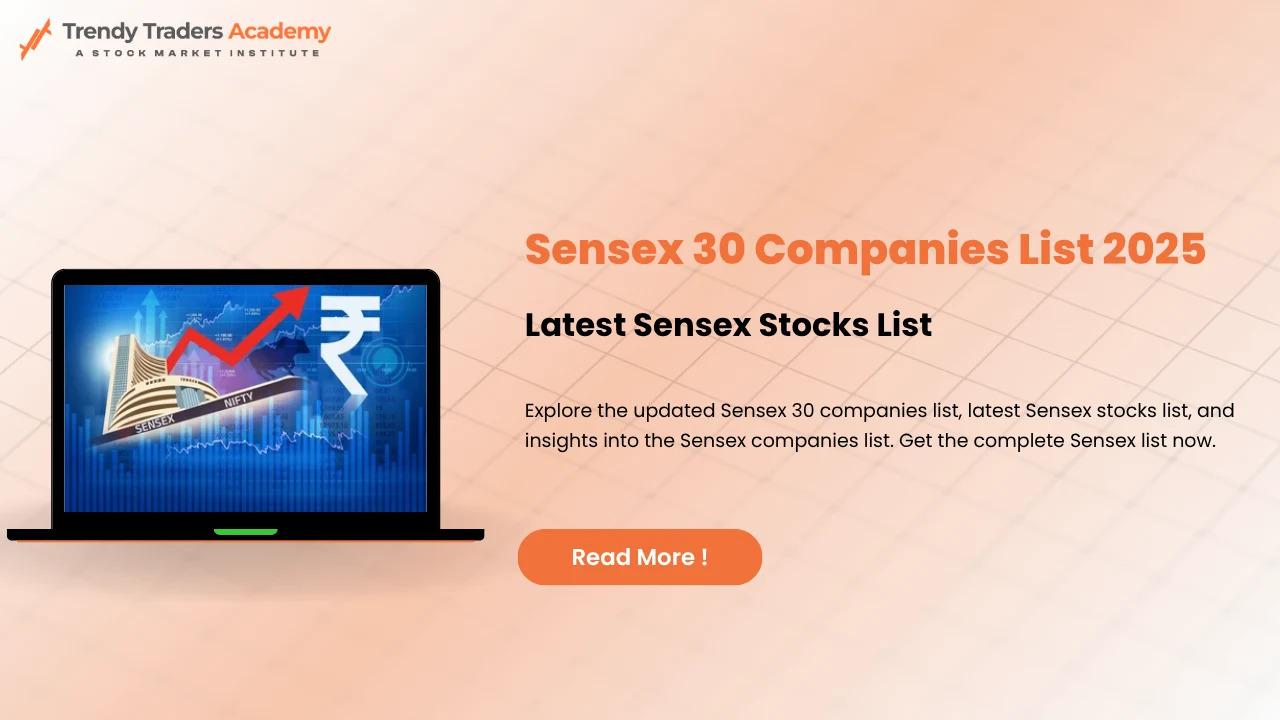Sensex 30 Companies List & Equity Market Guide

Sensex 30 Companies List: Your Complete Guide
Have you ever wondered who the top players in the Indian stock market are? Or maybe you're just starting out in trading and want to understand where to begin? Either way, knowing the Sensex 30 companies list is a great place to start.
Think of the Sensex like the Indian cricket team — the best performers who represent the market on the world stage. In the world of investing, these 30 companies are the star players that every investor, beginner or expert, should know.
In this guide, we’ll break down the Sensex 30, explain how they’re selected, and why they matter to you — whether you're curious about investing, already taking equity trading courses, or considering a technical analysis course.
Explore the latest Sensex 30 companies list with insights on equity trading courses and technical analysis course for smart investing.
What is the Sensex?
The Sensex, or the S&P BSE Sensex, is a stock market index representing 30 of the largest, most financially sound, and actively traded companies listed on the Bombay Stock Exchange (BSE). It’s like the heartbeat of the Indian economy — when Sensex rises, the mood is upbeat; when it falls, people worry.
Why the Sensex 30 Companies Matter
These 30 companies are considered the pillars of India’s corporate economy. They:
-
Represent major sectors like banking, technology, and energy.
-
Attract both domestic and international investors.
-
Set the tone for overall market sentiment.
If you're eyeing smart investing or even equity trading courses, starting with Sensex stocks is a logical step.
How Are These 30 Companies Selected?
It’s not random. Here’s what determines inclusion:
-
Market capitalization: Only the big players.
-
Liquidity: They must be actively traded.
-
Sector representation: To ensure balance.
-
Financial performance: Healthy revenue, growth, and profits.
So, the Sensex list isn’t static — it evolves with the market.
Complete Sensex 30 Companies List (As of 2025)
Here’s the most recent Sensex 30 companies list:
|
Company Name |
Sector |
|
Reliance Industries Ltd |
Energy/Conglomerate |
|
Tata Consultancy Services |
IT |
|
HDFC Bank Ltd |
Banking |
|
ICICI Bank Ltd |
Banking |
|
Infosys Ltd |
IT |
|
Hindustan Unilever Ltd |
FMCG |
|
Kotak Mahindra Bank |
Banking |
|
Larsen & Toubro Ltd |
Infrastructure |
|
Axis Bank Ltd |
Banking |
|
Bajaj Finance Ltd |
NBFC |
|
Bharti Airtel Ltd |
Telecom |
|
Maruti Suzuki India Ltd |
Automobile |
|
ITC Ltd |
FMCG |
|
Sun Pharmaceutical |
Pharmaceuticals |
|
HCL Technologies Ltd |
IT |
|
UltraTech Cement Ltd |
Cement |
|
Power Grid Corp |
Power/Utility |
|
NTPC Ltd |
Power |
|
Mahindra & Mahindra Ltd |
Automobile |
|
Asian Paints Ltd |
Paints |
|
Nestlé India Ltd |
FMCG |
|
SBI (State Bank of India) |
Banking |
|
Titan Company Ltd |
Consumer Durables |
|
Tech Mahindra Ltd |
IT |
|
Bajaj Finserv Ltd |
NBFC |
|
IndusInd Bank Ltd |
Banking |
|
Tata Steel Ltd |
Metal/Steel |
|
JSW Steel Ltd |
Steel |
|
Dr. Reddy’s Labs |
Pharmaceuticals |
|
Wipro Ltd |
IT |
Sector-Wise Breakdown of Sensex 30
Understanding sector spread helps you diversify:
-
Banking & Finance: 9+ companies
-
IT: 6 companies
-
FMCG: 3 companies
-
Automobile: 2 companies
-
Energy/Power: 3+ companies
-
Others: Cement, Telecom, Pharma, etc.
This distribution shows balanced sector exposure — ideal for investors who want to avoid putting all their eggs in one basket.
How Sensex Reflects Market Health
You can think of the Sensex like a thermometer for India’s economic climate:
-
Rising Sensex? Confidence and growth.
-
Falling Sensex? Uncertainty or crisis.
A well-performing Sensex usually signals a good time for long-term investment or enrolling in an equity trading course.
Investing in Sensex Companies
Here’s why these companies are worth investing in:
-
Stability: Backed by strong fundamentals.
-
Performance: History of long-term gains.
-
Trust: Widely tracked by analysts and institutions.
Even beginner investors can start here — many mutual funds and ETFs are based on the Sensex.
Equity Trading Courses for Beginners
Want to trade these companies but don’t know where to begin?
An equity trading course can teach you:
-
How the stock market works.
-
How to buy/sell shares.
-
Risk management.
-
Portfolio building.
It’s like learning to swim before diving into the pool — absolutely essential.
What is a Technical Analysis Course?
A technical analysis course is where charts become your best friend.
It covers:
-
Candlestick patterns
-
Volume analysis
-
Moving averages
-
Momentum indicators
Think of it as reading the "body language" of stocks. When done right, it can offer timely buy/sell signals even for Sensex giants.
How to Analyze Sensex Companies Technically
Here’s how a technical view of Sensex companies works:
-
Identify Trends: Use moving averages to spot bullish/bearish moves.
-
Look for Patterns: Triangles, Head & Shoulders, etc.
-
Use Indicators: RSI, MACD, Bollinger Bands.
Enroll in a technical analysis course to go deeper and backtest your strategies.
Growth & Historical Performance of Sensex
Let’s get a bit nostalgic.
-
1980s: Sensex was below 200 points.
-
1990s: Liberalization led to rapid growth.
-
2000s-2020s: IT boom, global trade, and reforms took Sensex past 60,000+.
Investing in Sensex companies historically has created wealth for long-term holders.
Passive Investing via Sensex ETFs
Don’t want to pick individual stocks?
Try Sensex-based ETFs (Exchange Traded Funds). These:
-
Mirror the index
-
Are low-cost
-
Offer diversification
Perfect for hands-off investors or those just completing their equity trading courses.
Common Myths About Sensex Stocks
Let’s bust a few:
-
“Only rich people can invest in Sensex companies”
False. Even ₹100 can buy ETFs or fractional shares. -
“Sensex stocks don’t grow fast”
Wrong. Many like Infosys, HDFC Bank have shown explosive growth. -
“You don’t need to study to invest”
Big mistake. A technical analysis course or trading course helps avoid costly errors.
Risks in Trading Sensex Stocks
Even big companies carry risk:
-
Market volatility
-
Economic downturns
-
Regulatory changes
Always research, use stop-loss, and continue learning through equity trading courses.
Conclusion & Smart Learning Path
The Sensex 30 companies list is more than just names. It’s a gateway into India’s financial world — full of growth, opportunities, and learnings.
If you're starting your journey in stock trading, begin by studying these companies. Pair that with a good technical analysis course or equity trading course, and you’ll be well on your way to becoming a confident trader.
FAQs
What are Sensex 30 companies?
These are the top 30 companies listed on the BSE, selected based on market cap, liquidity, and financial performance.
How can I invest in Sensex companies?
You can invest directly in individual stocks or through mutual funds and ETFs that track the Sensex.
Are Sensex companies safe to invest in?
While they’re considered stable, all investments carry risk. Research and diversification are key.
What is the benefit of taking a technical analysis course?
It helps you understand market trends, timing entries/exits, and reducing risks with data-backed decisions.
Where can I find a good equity trading course?
You can explore online platforms, reputed institutes, or financial learning websites offering beginner to advanced courses.







